Solar cooking brings a sustainable twist to your campsite meals, letting you create hearty soups without traditional fuel. You'll need basic equipment like a box or panel cooker, dark-colored pots, and essential tools such as thermometers and pot holders. From classic vegetable to spicy sausage and bean, five budget-friendly one-pot soups await your outdoor culinary adventures. You can expect 4-6 hours of cooking time, perfect for setting up camp or exploring while your meal simmers. Position your cooker in direct sunlight, adjust every 30 minutes, and watch your wilderness dining experience transform into something extraordinary.
Essential Solar Cooking Equipment
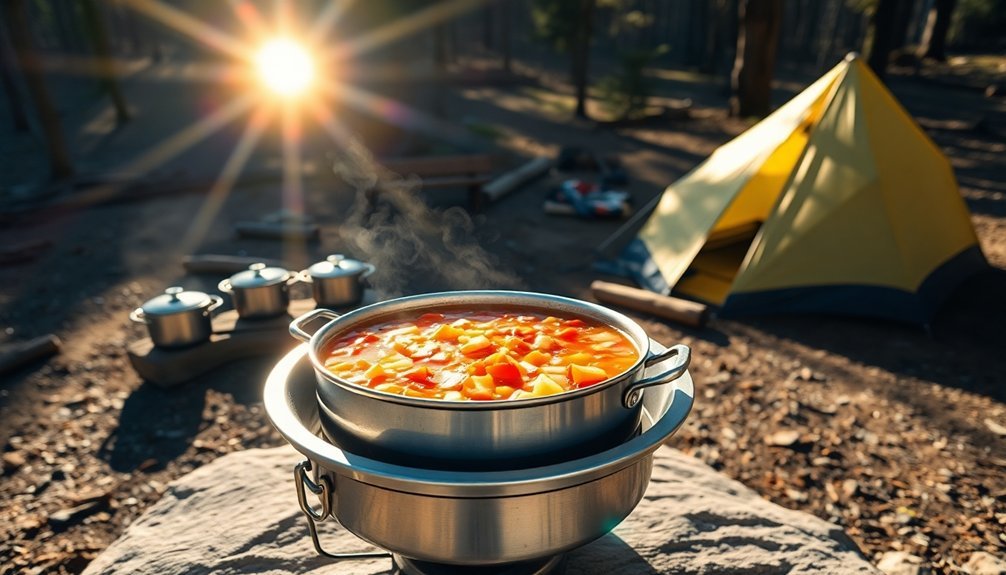
Solar cooking enthusiasts need three main types of equipment to prepare campsite meals: cookers, containers, and essential tools.
For your campsite soups, you'll want to choose between four cooker styles: box cookers for steady heating up to 300°F, panel cookers for economical cooking up to 248°F, parabolic dishes for quick high-heat cooking, or vacuum tube cookers for versatile performance up to 550°F.
Your cooking containers should include black pots or clear glass casseroles to maximize heat absorption. Make sure to line your cooking vessels with aluminum foil for optimal heat reflection and retention.
Don't forget to pack high-temperature baking bags to lock in moisture and heat while your soup simmers. You'll also need foil-lined cardboard panels to reflect sunlight onto your cooking vessel.
Essential tools include a reliable thermometer that reads up to 300°F, pot holders for safe handling, and a wooden spoon for periodic stirring.
Pack multiple layers of insulation materials like newspapers or cardboard to maintain consistent cooking temperatures.
Remember to bring clear plastic wrap or glass to trap heat effectively.
For best results, you'll need to reposition your cooker every 15 minutes to follow the sun's path, ensuring your soup cooks evenly.
Solar-Safe Recipe Preparation Tips
Before starting any solar-cooked meal, preheat your oven to at least 250°F and monitor the temperature with a reliable thermometer.
You'll need to refocus your oven every 30 minutes to maintain consistent heat and follow the sun's path, which helps reduce overall cooking time.
Choose dark-colored metal or glass pots with tight-fitting lids for your soups, as these materials absorb and retain heat most effectively.
Don't use plastic containers, as they can melt or release harmful chemicals at high temperatures.
Keep your pot covered as much as possible to maintain steady cooking temperatures. Solar ovens prevent food from drying out or burning unlike conventional ovens.
When preparing ingredients, cut vegetables and meats into smaller, uniform pieces to guarantee faster cooking.
Season your ingredients before placing them in the pot, and combine everything at once to maximize efficiency.
You'll want to stir occasionally but minimize lid lifting to prevent heat loss.
Remember that solar cooking takes longer than conventional methods – expect 4-6 hours for most soups.
Don't worry if you need to adjust cooking times based on available sunlight.
Keep checking the temperature throughout the cooking process, and reposition your oven as needed to maintain ideal heat.
Five Hearty One-Pot Soup Recipes
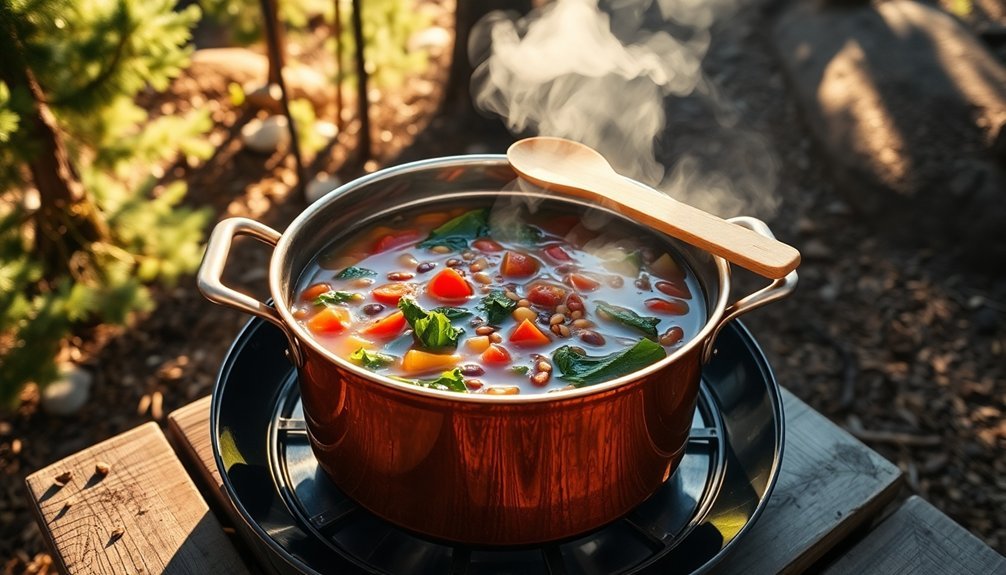
Now that you've mastered solar cooking techniques, let's put them to good use with five satisfying one-pot soups perfect for your camping adventures. Each recipe combines hearty ingredients like garlic, leeks, and your choice of protein with aromatic herbs and spices for maximum flavor.
You'll find these soups are remarkably adaptable, letting you switch between fresh or canned vegetables and different protein options to match your preferences. With a typical cost of 1€ per person, these recipes provide excellent value while feeding a group of four comfortably.
Create rich, satisfying meals while keeping cleanup minimal by trying these campsite favorites:
- Classic vegetable soup with roasted carrots, potatoes, and smoky paprika, finished with a swirl of coconut yogurt
- Spicy sausage and bean soup loaded with herbs, featuring your choice of traditional or vegan sausage
- Hearty chicken and vegetable soup with thyme and marjoram, perfect for cooler evenings
- Creamy potato and leek soup that's equally delicious with or without cream
Each recipe takes 30-60 minutes to prepare and can be scaled up or down depending on your group size.
You'll appreciate how these budget-friendly soups make the most of simple ingredients while delivering satisfying nutrition after a day of outdoor activities.
Campsite Safety And Storage
A well-prepared campsite requires careful attention to both safety protocols and food storage strategies.
When cooking your soups outdoors, you'll need to establish a secure fire pit away from brush and maintain a bucket of water nearby for emergencies. Never leave your cooking fire unattended, and make sure it's completely extinguished before retiring to your tent.
Store your soup ingredients in bear-proof containers or hanging bags at least 100 yards from your tent. You'll want to keep coolers with perishable items like meat and vegetables in a secure location away from direct sunlight. Pre-chill your cooler with ice blocks and store raw meats in sealed bags to prevent contamination.
Monitor weather conditions closely, as unexpected changes can affect your cooking plans. Keep your campsite clean by properly disposing of food scraps and packaging that might attract wildlife.
You'll need to wash your hands frequently while preparing soups, using sanitizer when water isn't available. Before starting your culinary adventure, check your equipment's condition and make sure you've informed someone about your camping location.
Mark any tent stakes or poles with bright fabric to prevent tripping hazards around your cooking area.
Smart Solar Cooking Techniques
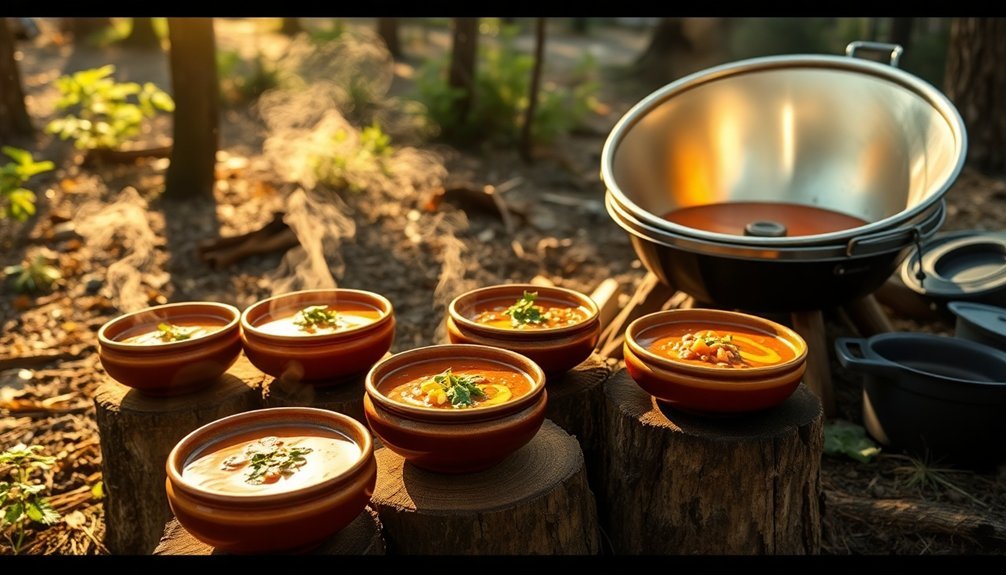
Solar cooking offers a sustainable and eco-friendly way to prepare campsite soups while minimizing fire risks. To get started, you'll need to position your solar cooker in direct sunlight and set up reflective surfaces to concentrate heat onto your cooking chamber. Pre-heat your oven for 15-20 minutes before adding your soup ingredients to guarantee ideal cooking temperatures.
Choose dark-colored cookware or cover your pot with a dark towel to maximize heat absorption. Your soup will cook more efficiently if you're using thin metal containers with good heat retention properties. Keep adjusting your reflector angles throughout the cooking process to follow the sun's movement and maintain consistent temperatures.
- Steam rising from your dark pot as sunlight streams through the glass window
- Aluminum foil reflectors gleaming as they direct sunlight into the cooking chamber
- A thermometer showing the steady climb in temperature as your soup simmers
- Aromatic vapors escaping each time you lift the pot's lid to stir
Remember to monitor weather conditions and adjust cooking times accordingly.
You'll find that soups and stews are particularly well-suited for solar cooking, as they benefit from the gentle, consistent heat that solar ovens provide.
Frequently Asked Questions
Can Solar-Cooked Soups Be Prepared on Cloudy or Partially Overcast Days?
Yes, you can make solar-cooked soups on cloudy or partially overcast days, but you'll need longer cooking times. As long as you can see a shadow, there's enough sunlight to cook, though temperatures will be lower.
How Long Should Leftovers Be Stored in a Cooler While Camping?
You'll need to discard any leftovers that have been in the "Danger Zone" over 2 hours (or 1 hour if it's above 90°F). Make sure your cooler maintains 41°F or lower with plenty of ice.
What's the Best Way to Clean Solar Cooking Equipment at Campsites?
You'll want to use biodegradable soap and soft cloths to clean your solar cooker and cookware. Don't scrub reflective surfaces harshly. Wipe gently with damp cloth, dry thoroughly, and inspect for damage.
Can Frozen Ingredients Be Used Directly in Solar-Cooked Campsite Soups?
Yes, you can add frozen ingredients directly into your solar-cooked soups without thawing them first. They'll defrost and cook as the soup simmers, though you'll need to adjust cooking times and liquid amounts accordingly.
Do Solar Ovens Work Effectively at High-Altitude Camping Locations?
Yes, you'll find solar ovens work exceptionally well at high altitudes. You're getting more intense sunlight and clearer skies there, which actually improves their efficiency. They'll cook your food effectively even in cold temperatures.
In Summary
You'll find solar cooking brings a whole new dimension to your camping culinary adventures. With these five simple soup recipes and proper equipment, you're ready to harness the sun's power for delicious meals. Remember to follow safety guidelines, plan your cooking times around peak sunlight hours, and always store leftovers properly. You've now got everything needed to create sustainable, flavorful campsite meals without traditional fuel sources.

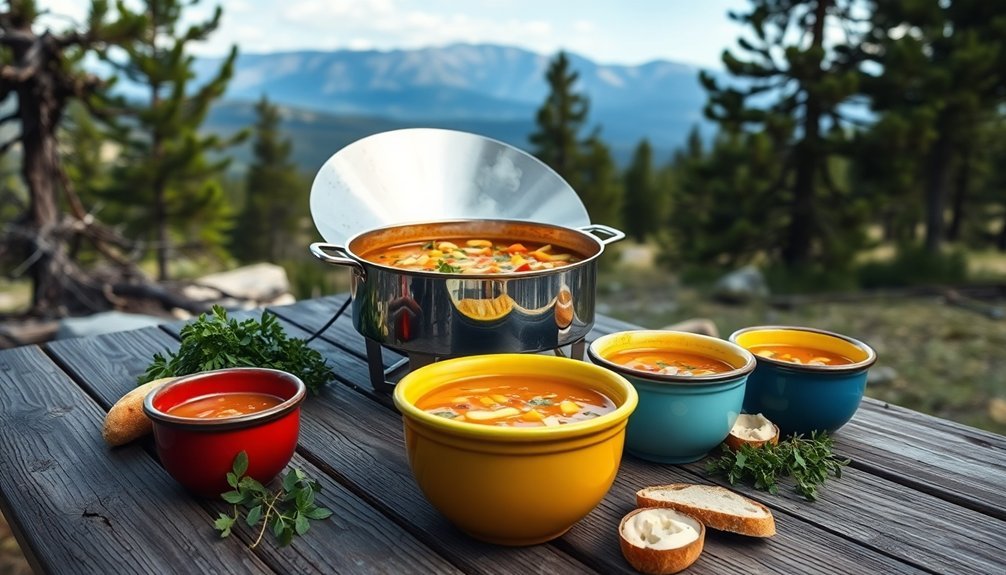
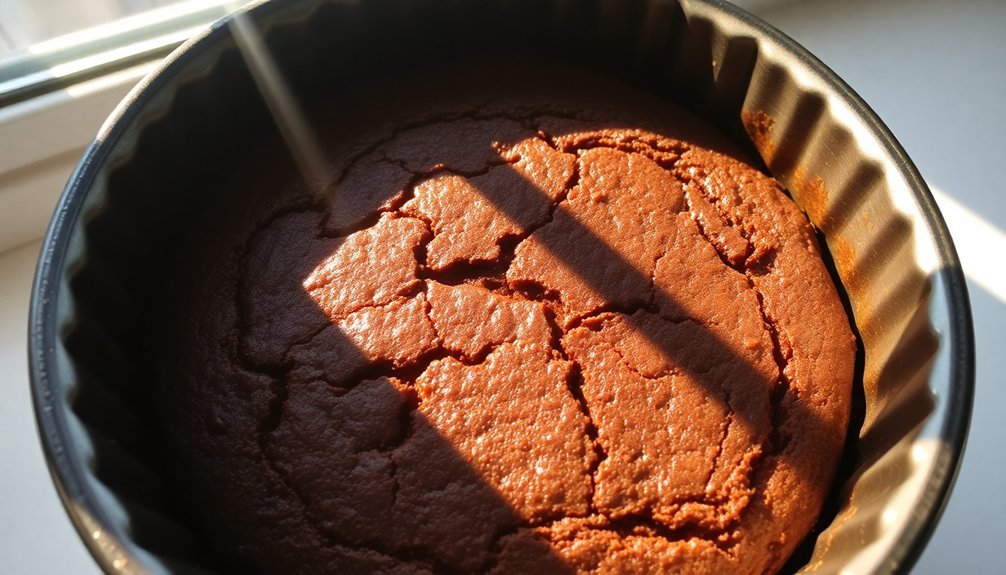
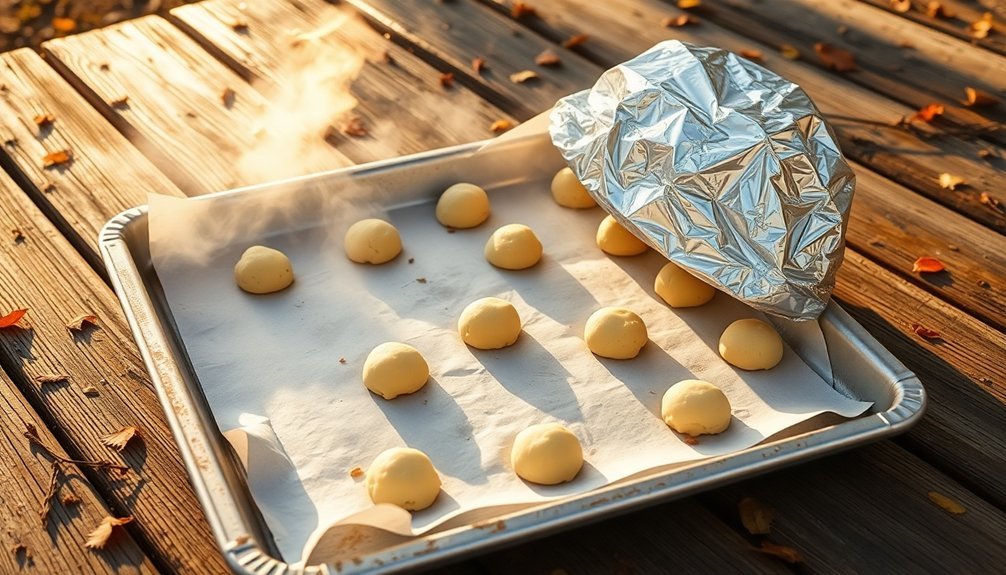
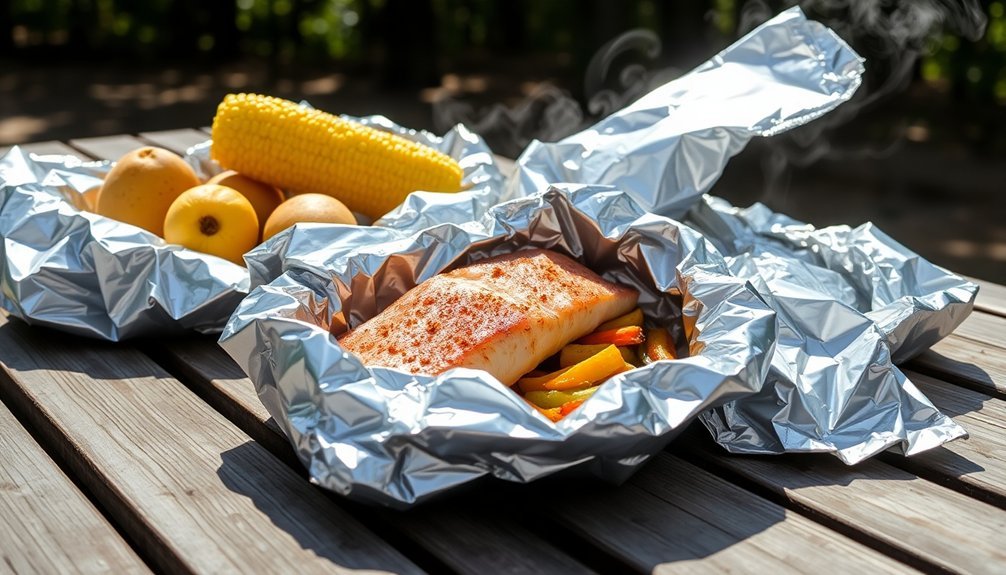
Leave a Reply